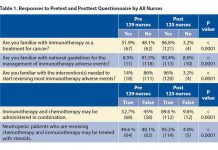By Carol Brimacombe, State Registered Occupational Therapist (SROT)
Posted: October 2017
The emerging role of allied health professionals in the multidisciplinary thoracic cancer team (MDT) is only just being acknowledged by the wider oncology community. How best to define and integrate their role into disease management remains a challenge.
In the United Kingdom (UK), patients with cancer are supported by specialist nurses with expertise in each specific tumor site. In Oxfordshire, a county in Southern Central England with a population of nearly 700,000 and covering just over 1,000 square miles, the lung cancer nursing team sees over 300 patients newly diagnosed with lung cancer annually, many of whom experience the inevitable decline in health and functional status that comes with a diagnosis of advanced lung cancer. The nursing team had long been acutely aware of the threat that this disease imposes on an individual’s independence and dignity and of the added pressures on family and caregivers struggling to support a loved one. The lung cancer nurses and the wider MDT completed an internal review of the service being offered to patients. A lack of timely therapy provision was identified as an area of need. It was concluded that having an occupational therapist (OT) join the team would significantly expand and diversify the service that could be offered to patients. Lung cancer therapy goals were identified as:
a) Work with patients and caregivers to anticipate functional needs rather than waiting for a crisis to occur
b) Provide a rapid, flexible, and responsive service to those with existing needs
c) Include a keyworker role outside of traditional therapy expertise who supports patients at diagnosis, helps with treatment decisions, and provides information
While all MDT members share a keyworker role, which includes supporting people through their diagnostic journey, having an OT be present and involved from the point of diagnosis onward is an original way of working for an OT and the MDT.
Funding for the post was obtained from Macmillan, a leading UK-based cancer charity, and I was recruited and embedded into the nursing team and employed full time as an Advanced Therapist Practitioner (ATP). Referrals were received from all members of the MDT, inpatient teams, primary and palliative care. Interventions included home assessment, outpatient clinic review, breathlessness and anxiety management, and provision of aids, support, education, and advice.
Data were gathered from 305 new lung cancer patients, 165 (54%) of whom had identified therapy needs. An addias part of a generic keyworker role. The number of referrals (205) resulted in a total of 1,005 interventions averaging 5 per person. The value of the role was measured 3 ways: User Feedback Event, Satisfaction Questionnaire, and a Stakeholder Questionnaire. Outcomes were overwhelmingly positive; two of the principal benefits included the speed of response from referral to first contact and the advantages, on both a practical and human level, of being assessed at home.
Case Example: Mr. W, a patient with advanced, incurable mesothelioma, was referred to the ATP by the lung cancer specialist nurse following review at a pleural clinic where he presented with increasing functional difficulties. Previously active and independent, Mr. W and his wife were struggling to come to terms with his progressive disease and consequent decline in function.
ATP actions:
• Made 3 x home visits to build trust and rapport and assess Mr. W’s functional level within his home environment
• Identification of Mr. W’s extreme risk of falls and acknowledgment of his initial reluctance to make any changes to his home
• Recognition of Mr. W’s trouble managing bladder function and maintaining functional independence
• Provision of equipment, including bed lever, Mowbray toilet frame, urine bottle, and walking frame, to help maintain his independence, dignity, and function
• Urgent referral made to and liaison with District Nursing for pressure care assessment
• Urgent referral made to and liaison with Community Palliative Care
• Communication conduit with patient’s primary pleural consultant to confirm outcome/advice from clinic appointment, which ATP communicated to the primary care physician on same day
Outcome: Although Mr. W died 2 weeks after the first meeting, his wife was pleased with the services provided. At the first meeting, his wife had said that she felt “desperate and lost.” A week later she indicated that, while the situation was still horrible, she felt that everything was in place for her husband’s care, and she felt in control.
It should be noted that interactions of this sort, if implemented properly, can allow terminally ill thoracic oncology patients to die at home with dignity and without unnecessary hospitalizations. The Oxfordshire experience provides a template for the rest of the UK as well as the rest of the world. ✦











